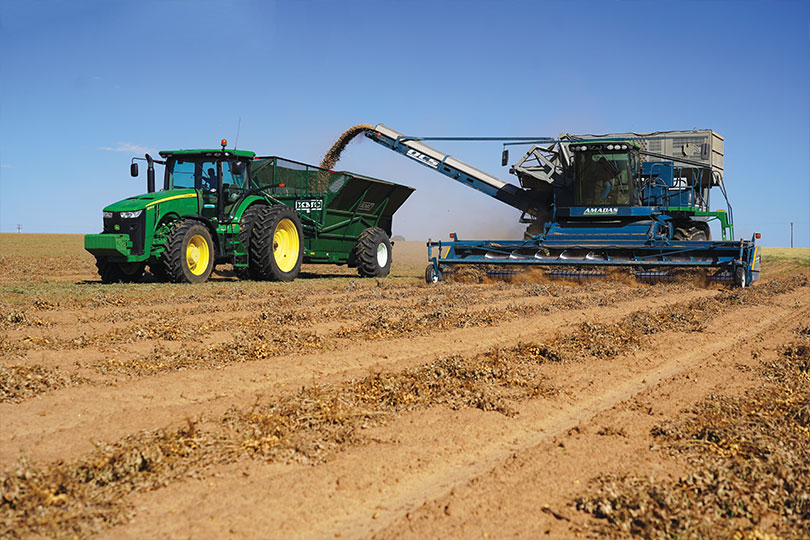By Julie Tomascik
Editor
In the Texas Panhandle, a few things are for certain—the wind will blow, the cotton will grow and so will peanuts.
For Michael Newhouse, who farms in Donley County, growing peanuts works well with his crop rotation.
“We’ve grown Spanish. We’ve grown Runners, and we try to save our best ground for Virginias. They’re really susceptible to disease. We don’t have a guaranteed place for Virginias every year, but if we have an opportunity, we try to grow them,” Newhouse said. “They usually bring really good money.”
The soil in Donley County, and across the Panhandle, is ideal for growing peanuts.
“Our soil type is really good for peanuts, and we like to rotate our cotton with peanuts,” he said. “It seems to cut out our diseases. We don’t have as much disease pressure if we rotate cotton and peanuts, and vice versa.”
Since peanuts are legumes, they grow underneath the soil. They’re known as nature’s zero waste plant, because everything from the roots to the hulls are used.
Peanut plants also have a unique ability to improve the soil. They take nitrogen from the air and produce their own in the ground, which benefits other crops, as well. And with fertilizer prices steadily climbing, it’s a benefit that peanuts don’t require as much fertilizer.
That’s a vital part of the equation for maximizing yield and efficiency, and this year’s growing season was a good one.
“It rained pretty often. I can’t remember exactly how much we got, but the rain just was incredible,” he said.
The difference between peanuts and other nuts is the water needed to grow the crop.
“Take an almond for example. It takes 5 gallons of water to produce an ounce of peanuts. It takes 80 gallons of water to produce an ounce of almonds,” he said. “Up here, where water is scare and we don’t know how long it’s going to last, we feel like we’re doing our part growing peanuts and conserving water.”
The crop takes about six months to grow. Newhouse typically plants around the first of May and digs the peanuts at the beginning of October.
“In September, usually mid-September or so, we’ll start scratching peanuts,” he said.
To do a scratch test, Newhouse takes each pod and scrapes the hull. The color tells the maturity of the peanut. Immature peanuts have white inner husks. As the peanuts mature, their color darkens to orange, then brown and finally black.
“We like it when there’s a black scratch, kind of a caramel-looking color,” Newhouse said.
And then they dig them up.
“The digger goes in and runs about four inches deep, and there’s a big knife that runs under each row. That knife cuts right below where the root knife cuts right below where the root is,” he said. “You can cut too shallow and shave your peanuts, but if you get it set just right, it goes underneath the plant and it lifts it up onto a chain. And that chain is shaking. It shakes the dirt off. And as it goes over the back, it actually takes that plant and flips it 180 degrees and places it back on the ground.”
The peanuts will sit in the field, depending on weather, for about a week to dry. Then, they combine them.
They can harvest about 80 acres a day, Newhouse noted.
After months of work, Texas farmers are happy their peanut crop is in demand across the state and around the country.
Because during the height of the COVID-19 pandemic, baseball stadiums were closed to fans, and that meant the demand for the salty sports snack was low. But games are open to fans again, which is a big market for the Virginia variety—the largest of all peanut varieties.
“The Virginia is mainly used if you go to a ballpark, a racetrack or something like that,” Newhouse said. “They’re in-shell peanuts. That means they want the shell to be pretty. They want it to look nice for the consumer to say, ‘I want to eat this peanut.’”
Runners are known for having an attractive, uniform kernel and are typically used for oil and peanut butter. They are the most-widely consumed variety, according to the Texas Peanut Producers Board.
Valencia peanuts usually contain three or more kernels in a longer shell. They are a sweet peanut with a bright red skin. This variety is mostly served roasted or sold in-shell or boiled.
The Valencia’s primary producing region, according to the Texas Peanut Producers Board is in West Texas and New Mexico.
Spanish peanuts are used for peanut candies, peanut snacks and peanut butter.
“Spanish peanuts are mainly grown for PayDays, for your candies,” he said. “We grow a high oleic variety here, and because it’s a high oleic variety of Spanish, the shelf life is longer.”
From Newhouse’s field to the store, the ballpark or a sandwich, peanuts are a crowd favorite.
“It’s pretty neat to grow something that goes directly to the consumer,” he said. “A lot of these peanuts stay right here in the U.S. And if you go to the store and get a PayDay, it could be made with some Texas peanuts, and that’s really neat to me.”


My name is CarlLittle I’m interested in buying some valencia peanuts seed can you help me please and thank you